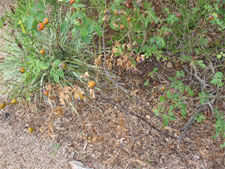Question and Answer – October 2009
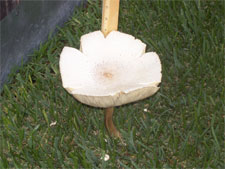
Question: This fall, we are having large white mushrooms growing in our St. Augustine lawn. We also have noticed them in the other lawns in the neighborhood. Every week they continue to spread. Is this a cause for concern? Tom, no city given.
Answer: Mushrooms are no cause for worry. They are saprophytic organisms. That means they live off decaying organic matter, not living plant tissue. They may come back for a year or two, but don’t let them bother you. Quite to the contrary, learn to enjoy their unusual character. There are so many different types. If you ever feel the need to remove them, just break them off with your shoe, cut them with the mower, or drag them down with a garden hose.
Question: Three of my young trees have bark damage. Possibly due to sun scald or abrasion from stakes. Should I re-plant vs. seeing them die over the next few years? Are they too damaged to survive? M.R., Rockwall
Answer: The pistachio looks like it does suffer from abrasion from the stake beside it. If you’ll protect it from that stake, it should heal fairly quickly next season. The skeletonized bur oak leaves have been stripped by sawflies. These insects are quite common, especially with younger bur oak and Shumard red oak trees. However, they do no significant long term damage. Odds are that you won’t see them again anytime soon. The trunk of your oak tree looks fairly serious. The old stub has started to decay within the trunk. You might want to stake and guy the trunk to keep it from snapping in a windstorm until it can develop more size and strength and wall off the decay. Or, you might be farther ahead just to replace it and let the new tree get started. I can’t tell from the one photo.
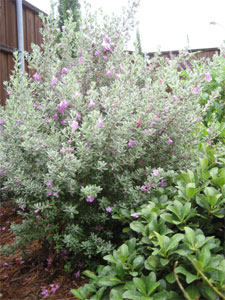
Question: I have several Silverado sage plants in our backyard flower bed. They were planted Oct. 2008. They are all doing well. One of the larger ones is leaning forward, and I am wondering if I can ground a stake and gently pull the shrub back and tie it to the stake? Or, if I trim it back quite a bit, would that encourage the growth to correct? It is beginning to grow over some shrubs in front of it, and the back of this particular sage doesn’t have the full growth. K.C., Allen.
Answer: Your photos show the plant to be growing fairly close to the fence. The fact that all of the light is coming from the one side is why the plant in question is leaning, much as a houseplant "grows toward a window." You could keep the plant somewhat more compact by trimming it gently into a nice, natural form. Avoid any formal globes or squares as you trim. However, you need to know that the plant’s genetics will take it right back to where it is now. This will be a recurring issue. You might want to consider resetting the plants 4 or 5 feet out from the fence while they’re dormant late this winter. It will become more difficult to move them as the years go by.
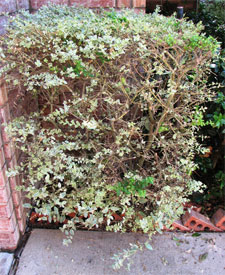
Question: I have a half-dozen variegated privet bushes planted in late 2001. After I even them up with a hedge trimmer, you can see a lot of old, thick brown branches and holes that never fill in with new growth. If I trim the bushes down close to the ground, will they regrow? If so, how far down can I trim and when is the best time? D.D., Richardson.
Answer: (This is a note from a long-time friend. Please forgive my saying Hi.) It’s a bad news/good news kind of question. Here’s the bad news: privets’ normal height, if left untrimmed, is 12 to 18 feet. Anytime we take a plant that tall and try to maintain it at only a couple of feet, it eventually will regress after each trim. We end up cutting off the ends of small twigs where the new leaves are. Only the very large trunks and limbs, as well as the small, dead twigs are left behind. The good news is that privets do come back from severe pruning. The bad news is that they may come back solid green, depending on the tissues that are left to resprout. The good news is that it doesn’t cost anything to try. That kind of severe cut would be made in late winter.
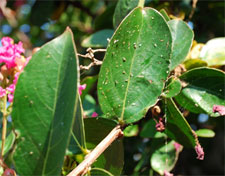
Question: Help! I have a recurring aphid problem on my crape myrtles. Each August, I get a heavy infestation. They suck the life out of the leaves and leave behind a sticky mess. The first year, I left it alone and it was horrible looking. But the trees came back nicely. Last year, I used a bug spray and they were controlled but it killed about every living thing on the tree. So this year, I tried to go natural. I’ve sprayed a little dish soap from a hose-end sprayer… the insecticidal soap approach. It’s kept the numbers down, but it is still a problem. So, what approach do I take next year? I need something that I can use in a full-size tree. Do I bring in a truck load of lady bugs? Please help my beautiful trees. M.R., Keller.
Answer: (A similar question came from another long-time friend. Please forgive a shout out to Paris!) My recommendation has always been to use a systemic insecticide. There are liquids and granules on the market. Talk to an independent retail garden center and ask for help from a Texas Master Certified Nursery Professional. I have had much better luck with the systemics than I’ve had with other products. You need to treat a couple of weeks earlier than you traditionally first see the pests to give the insecticide time to be taken into the plant.
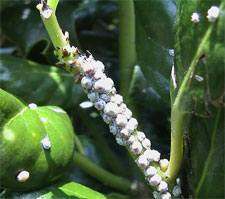
Question: I have a holly bush in the front flowerbed which has some peculiar little growths on the leaves and stems. They appeared for the first time last year in the summer and stayed on the plant through the winter. They have multiplied this season. The shrub is approximately 7 ft. tall and “appears” to have no ill effects from these growths. Suggestions? B.B., Valley Ranch.
Answer: These are scale insects. There are many types of scales that bother plants to one degree or another. Leave them if you wish, but you do need to monitor their populations. Most of us prefer not to have scales sucking on our plants. A systemic insecticide should make easy work of them. You could also apply a horticultural oil spray to the plants in late January or February. Apply according to label directions.
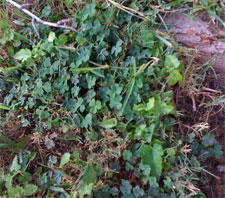
Question: I have St. Augustine grass, and over the past couple of weeks have noticed these weeds all around my yard. J.W., no city given.
Answer: Welcome to the wonderful world of clover! We have several common types in our Texas lawns. The best control of existing clover plants is a broadleafed weedkiller containing 2,4-D applied according to label directions. That’s the same material you’d use to control dandelions, poison ivy and other non-grassy weeds. Your local retail nurseryman will be able to help you.
Question: This summer I have begun having problems with whole canes on my roses suddenly dying. The first one was an old rose that I have had for over 25 years. It was rooted from a cutting of a bush at an old home in Alvin. I thought at first it was just old age, but almost half of the bush has died. Now, I have seen a similar thing happening on one of my Katy Road Pink/Carefree Beauty roses, and on a La Marne. Those two are not old bushes, but are well-established, having been in the ground for over 3 years. I have nearly 30 varieties of roses, almost all of them Earth-Kind, and I have never seen anything like this. The rest of the bush looks healthy. The La Marne even has blooms. All of the leaves on the whole cane suddenly turned brown. Due to the extreme drought and heat, I have given them some supplemental watering. Could this be caused by drought, or is it more likely a disease? G.R., no city given.
Answer: It’s difficult to tell from the angle of the photos. Drought could certainly cause this if you’re in a part of Texas that was hit so hard by the dry weather, but I also see a few specks of black spot. Cotton root rot can also cause roses to die out, but only in areas where the soils are alkaline. (This is why I need to know where you are when you send me a question.)
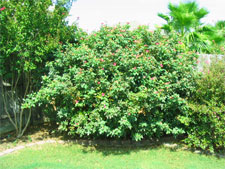
Question: My Knock Out rose is 7 years old. I trim it to 6 feet every winter. It blooms well in the spring, but then it doesn’t bloom well after that. How can I get better blooms in the summer and fall? S.S., no city given.
Answer: Most roses, Knock Outs included, go out of bloom for 8 to 12 weeks during the most brutal part of the summer. They are blooming beautifully across Texas again now. Hopefully, yours are, too. Trim them by one-half in mid-February, and by one-third in early August to promote vigorous new growth and bud set.

Question: I have a low area in my back yard (almost a ditch). It is in heavy shade, so not much grows. The problem is that it washes the blackland dirt away in the summer and fall when there is a heavy rain. I use ryegrass in the winter and spring to hold the soil. What can I use in this area other than gravel or groundcover to hold the soil? G.J., Ovilla.
Answer: I have a similar situation in my own blackland landscape, and I have used paving bricks and concrete paving stones as my walk. I have surrounded it with mondograss (regular monkeygrass). It’s a groundcover (against your wishes), but it’s the very best thing to hold soil in periods of heavy, washing rains. No turfgrass is going to stay there in all that shade. I have also used river rock (orange- and grapefruit-sized) to hold soil in another similar spot.
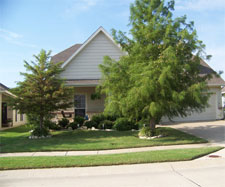
Question: I am hoping you can tell me what is wrong with my bald cypress tree. The two trees in the picture were planted at the same time, but as you can see, one is much smaller. The needles in the middle of the smaller tree are turning brown and there is a reddish black sap dripping from splits in the trunk. Please advise what I should do. L.H., McKinney.
Answer: Comparisons can be really confusing and frustrating. The smaller tree either was injured during planting or in successive years in your landscape. It’s also likely that the righthand tree gets much more water due to its proximity to the concrete driveway. Moisture is held beneath concrete. The roots are assuredly there. Our magazine offices are in McKinney, so I drive our streets often. If you look at 25 bald cypress trees in your hometown, even along Central Expressway, you’ll see all kinds of conditions at this point in the growing season. Some will be green like your larger tree. Others will be yellowed from iron deficiency. Others will be showing browned needles left over from the summer’s heat and drought. Bald cypress is a great tree where it does well, but in dry, alkaline soils, especially where white caliche bedrock is near the surface, they can be a disaster.
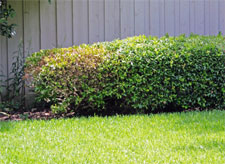
Question: – Attached is a photo of a holly shrub bed. As you can see, one section is dying (and has died since this was taken). A similar section died on the far right in the back. Any ideas on what has happened and how we might prevent the rest from dying? This shrub row gets a lot of sun, but it has never died off like this. We have also lost Indian hawthorns, and our neighbors lost their photinias. C.A., Dallas.
Answer: This is dwarf Chinese holly, and the dieback could come from several different causes. If the plants got very dry just one time, they would die back like this. You also appear to have trimmed them at the same height for some time, so they may be doing the same thing my friend’s variegated privet is doing (see above) – they may have just run out of steam due to repeated pruning. Check the backs of the leaves for scale insects. I’m guessing you would have seen them already, and that they would have been included in your question. This is unrelated to the Entomosporium leaf spot that probably got your neighbor’s photinias and your Indian hawthorns. Hollies do not have that disease problem.




